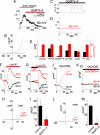A common mechanism underlies stretch activation and receptor activation of TRPC6 channels
- PMID: 17056714
- PMCID: PMC1637625
- DOI: 10.1073/pnas.0606894103
A common mechanism underlies stretch activation and receptor activation of TRPC6 channels
Abstract
The TRP family of ion channels transduce an extensive range of chemical and physical signals. TRPC6 is a receptor-activated nonselective cation channel expressed widely in vascular smooth muscle and other cell types. We report here that TRPC6 is also a sensor of mechanically and osmotically induced membrane stretch. Pressure-induced activation of TRPC6 was independent of phospholipase C. The stretch responses were blocked by the tarantula peptide, GsMTx-4, known to specifically inhibit mechanosensitive channels by modifying the external lipid-channel boundary. The GsMTx-4 peptide also blocked the activation of TRPC6 channels by either receptor-induced PLC activation or by direct application of diacylglycerol. The effects of the peptide on both stretch- and diacylglycerol-mediated TRPC6 activation indicate that the mechanical and chemical lipid sensing by the channel has a common molecular mechanism that may involve lateral-lipid tension. The mechanosensing properties of TRPC6 channels highly expressed in smooth muscle cells are likely to play a key role in regulating myogenic tone in vascular tissue.
Conflict of interest statement
The authors declare no conflict of interest.
Figures




References
-
- Ramsey IS, Delling M, Clapham DE. Annu Rev Physiol. 2006;68:619–647. - PubMed
-
- Montell C. Sci STKE 2005. 2005:re3. - PubMed
-
- Putney JW. Pflugers Arch. 2005;451:29–34. - PubMed
-
- Venkatachalam K, van Rossum DB, Patterson RL, Ma HT, Gill DL. Nat Cell Biol. 2002;4:E263–E272. - PubMed
-
- Xu SZ, Beech DJ. Circ Res. 2001;88:84–87. - PubMed
Publication types
MeSH terms
Substances
Grants and funding
LinkOut - more resources
Full Text Sources
Other Literature Sources

